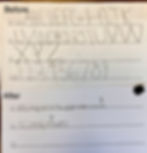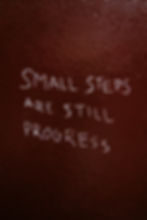Handwriting Expectations by Grade: Why Milestones Matter (And How to Track Them)
- Kelli Fetter
- Feb 19, 2024
- 3 min read
Updated: Oct 28
At Handwriting Solutions, our biggest goal is PROGRESS! You've heard the saying progress > perfection, right?! Well that is what we strive for... making steady gains to lead to legibility (can you read it?), automaticity (does it flow?), and efficiency (is it timely?) with writing. These skills unlock confidence, reduce homework battles, and lay the foundation for academic success.

Progress can be measured in a variety of ways.
For our tutoring clients we informally measure a student's progress each session, PLUS every second month we use a progress measure rubric. This rubric is based on handwriting expectations for your child's grade. We can easily see where your student has grown as a writer, what strengths they can leverage, and what areas are still emerging. Finally, we complete a full re-assessment upon parent request or after 3-6 months.
But here’s the problem: Often parents aren't quite sure what to expect at each age or grade. Without clear benchmarks, it’s easy to miss red flags—or worse, panic over normal developmental quirks.

So we have made it easy for YOU!
Below you will see grade level expectations for students in Kindergarten.
These are standards are sourced from Learning Without Tears and The Core Standards.
If you sign up for our Free Handwriting Expectations Guide you will also get the full list for:
1st grade
2nd grade
3rd grade & beyond
cursive handwriting
3 Ways to Use These Handwriting Milestones
These milestones aren’t just a checklist - they’re your roadmap to meaningful progress. Think of them as a flashlight in the fog of “Is my child on track?” confusion. These benchmarks do more than highlight skills; they empower you to take action, collaborate with teachers, and replace worry with confidence. Whether your child is flying through letters or hitting roadblocks, here’s how to turn these milestones into your secret weapon:
Track Progress: Use them as a checklist to celebrate wins (“Look how far you’ve come!”) and spot struggles early. For example, if your kindergartener masters pencil grip but still reverses letters, you’ll know exactly where to focus.
Advocate at School: Most teachers juggle 20+ students and rarely get handwriting training. Share this guide to align goals and say, “Here’s where we’re seeing challenges—how can we work together?”
Reduce Anxiety: Stop Googling “normal handwriting for 2nd grade” at midnight. With clear benchmarks, you’ll swap “What’s wrong?” panic for “Okay, let’s tackle this” clarity.
Handwriting Expectations in Kindergarten
(Your child should master most of these by the end of Kindergarten)
Correct and efficient pencil grip for writing |
Stabilize paper with non-writing hand while drawing and writing |
Position writing paper appropriately |
Maintain sitting posture for writing, coloring, and drawing |
Demonstrate skills in printing most letters and numbers from memory. |
Demonstrate correct formation of letters and numbers
|
Orient letters and numbers correctly (with few reversals) |
Place letters and numbers on a baseline (within 1/8" above or below |
Write letters and numbers in a grade-appropriate size |
Write his/her name: begin with a capital |
Copy from near/far point |
Write two-to five-letter words using appropriate spacing between letters |
Write simple two-to three-word sentences
|
Spelling
|
For the full list of milestones from kindergarten to 3rd grade (& beyond) including cursive, don't forget to download our Free Handwriting Expectations Guide.
Let us know how your child is progressing through these outcomes!
“What If My Child Is Behind?”
First: Don’t panic! Handwriting development isn’t a race - it’s a journey, and every child moves at their own pace. If your child is struggling to meet certain milestones, start by focusing on their strengths. For example, if they love storytelling, use that passion to make writing exercises feel like adventures (“Let’s write a sentence about your favorite superhero!”). Pairing their interests with practice can turn resistance into engagement.
One of the most effective ways to bridge gaps is through multisensory practices. These strategies engage multiple senses (touch, sight, movement) to reinforce learning and make handwriting more effortless.
Still feeling unsure?
You don’t have to figure this out alone. If your child struggles with these milestones, book a FREE 15-minute consultation with us to find out how we can help you identify the root causes (whether it’s fine motor skills, learning challenges, or something else) and create a personalized plan to close gaps without overwhelm. Think of it as a roadmap tailored to your child’s unique needs and strengths.


